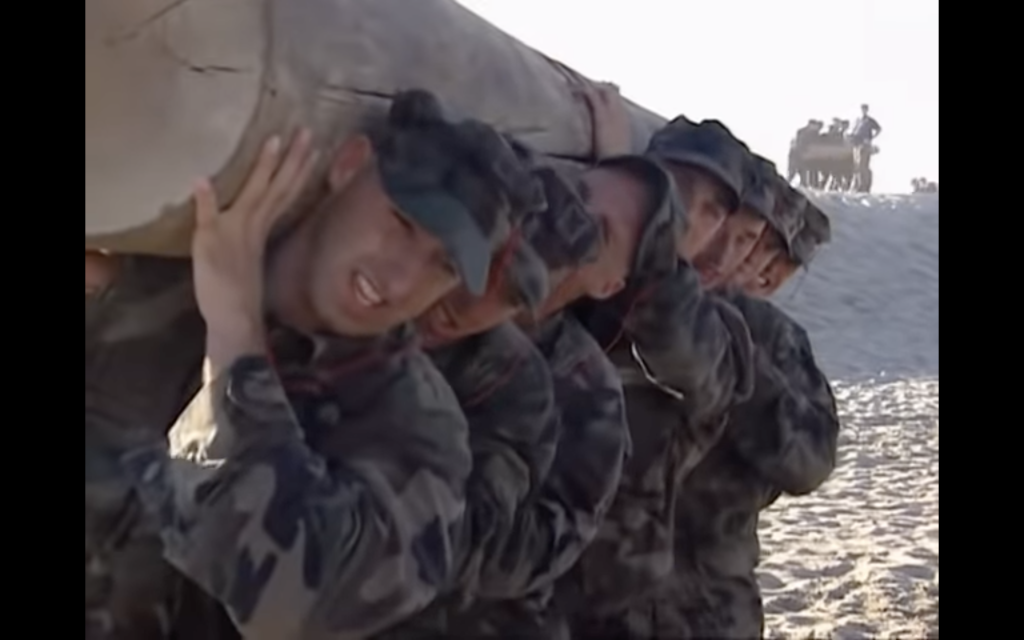
Navy SEAL training – Basic Underwater Demolition / SEAL training more commonly known as “BUD/S” is brutal. It is supposed to be. The graduates have trained for, served in, fought, and died in every conflict since WWII. Our original Navy Frogmen forefathers, the Naval Combat Demolition Units (NCDUs) who cleared Omaha and Utah beaches during the Normandy invasion suffered 52% casualties on D-Day. More than 100 Frogmen were wounded or killed clearing obstacles to the beaches. Three NCDU teams were completely wiped out.
America’s “First Frogman”, Lieutenant Commander Draper Kauffman, the original Commander of the Naval Combat Demolition Unit training school at Fort Pierce, Florida established the baseline that all NCDUs, Amphibious Scouts and Raiders, Underwater Demolition Teams (UDT) and Sea Air and Land (SEAL) commandos have gone through during the initial basic training.
Kauffman instituted a brutal training regimen culminating in a “Hell Week” of non-stop, intense physical exertion with less than an hour of daily rest over 6 days and 5 nights —a tradition that continues in modern Navy SEAL training today. Hell Week is the defining experience of BUD/S. 120+ hours spent cold, wet, and sandy, pushing limits of one’s physical endurance, mental toughness and pain tolerance. Surviving obstacle courses, surf torture, beach runs, ocean swims and paddling a rubber raft in boat crews in the Pacific Ocean.
It tests the limits of teamwork and the ability to perform under extreme physical and mental stress while being severely sleep deprived. Above all, it measures individual determination and “fire in the gut” motivation. On average, only a quarter of SEAL trainees make it through the week that pushes a man’s body to the extreme. Those who survive the world’s most grueling week of training come to the self-awareness that they will never, ever quit, or let a teammate down.
Between 1965 and 1972 there were 46 SEALs killed in Vietnam. 4 SEALs were lost at sea after parachuting into rough seas off the coast of Grenada during Operation Urgent Fury. 4 more were killed at Paitilla Airfield on the eve of Operation Just Cause to oust deposed Panamanian leader, Manual Noriega.
Since 9/11, 117 SEALs have died in training and combat operations around the world including Iraq and Afghanistan where the largest single day loss of US military personnel, 31 American servicemen (including 15 Navy SEALs) died when a CH-47 Chinook helicopter call sign “Extortion 17” was shot down on August 6th2010.
The Original Frogman (OF) Draper Kauffman instituted Hell Week in what is recognized as the toughest military training in the world for a reason. He knew his frogmen would be going into harm’s way where being wounded in action (WIA) or killed in action (KIA) would be the harsh reality while clearing beaches prior to amphibious landings in Africa, Italy, France, and the Pacific’s Island-hopping campaigns. Like every SEAL commander who followed in his footsteps, SEALs accept the training with the highest risks and most dangerous missions that the nation will call upon us to execute. It is why SEAL Team Six was tasked with Operation Neptune Spear, the mission to kill/capture Usama Bin Laden.
Recent deaths in SEAL training during Hell Week have brought outside calls to examine the training curriculum and make changes. A Navy Admiral from outside Naval Special Warfare is leading the review board and will likely call for reforms. While safety is always paramount, and steps to ensure lesson learned from the recent death of SEAL trainee Kyle Mullin should be implemented, any recommendation to alter or eliminate portions of Hell Week would be a mistake.
“The Only Easy Day Was Yesterday” is the student motto at BUD/S. The more you sweat in training the less you bleed in war… is the BUD/S Instructor mantra. It’s called Hell Week for a reason… war is hell. If you can’t survive Hell Week, you won’t survive life in the Teams much less future combat deployments. BUD/S is only an entry level glimpse into what actual SEAL platoon training will be like but doesn’t measure up to potential real-world missions in foreign lands under much more austere conditions than southern California environs can produce. You will be more exhausted, hypothermic, and sleep-deprived yet still be expected to execute a ‘no fail’ mission like a hostage rescue or kill/capture a high value target. The stakes will be life or death.
There are two more relevant maxims about war - Only the dead have seen the end of war and warriors will die training for war before ever seeing combat.
Commander Dan O’Shea (SEAL) USN (ret) graduated from BUD/S class 179 in 1992. A former Platoon and Task Unit Commander at SEAL Team THREE recalled to active duty after 9/11. A multi-tour Operation Enduring Freedom – Afghanistan and Operation Iraqi Freedom – Iraq veteran, O’Shea established and ran the Hostage Working Group at the US Embassy in Baghdad 2004 – 2006. Served his final combat tour as a counter- insurgency advisor for the Commander of International Security Forces – Afghanistan 2011 – 2012. During the chaos of the failed Afghanistan exit, O’Shea was a member of Task Force Pineapple that helped rescue thousands of Americans and Afghan partners left behind.